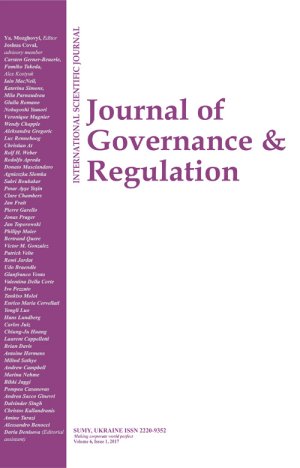
IS PRINCIPLE BASED LEGISLATION SMART CHOICE FOR CAPITAL MARKET’S REGULATION
Download This ArticleBorut Stražišar
Abstract
Global financial crisis in 2008 posted numerous questions about the reasons and triggers. In past three years world’s economic literature has been full of academic articles analysing each reason or trigger and scientific explanations of possible connections. Majority outcome was, that key factor was excessive use of derivatives and synthetic financial products, which were under regulated or not regulated at all. The outcome was that countries with developed financial markets introduced new regulations and controls in the field of derivatives and synthetic financial products. Term “systemic risk” was introduced in global financial market. But will this approach really prevent such global crisis? Submission is divided in three parts.
First part deals with the theory of principle based regulation. Principle based regulation was firstly introduced in UK and latter accepted by European Union in the field of capital markets. It was a way, together with the Lamfalussy process, to make EU regulation acceptable for all member states. Instead of detailed prescribed behaviour, legislation texts prescribe only desirable goals. Implementation is left to each state or, even worse, to each supervised subject. So the implementation should depend on the capital market’s development, capital product’s structure, tradition, investment companies’ size etc. From a distant view, principle based legislation could be seen as a great legislation writing’s technique. It could be seen as an effective solution to regulate a fast developing field without need to change the regulation. But is it true?
Second part of the submission addresses the legal questions and problems, connected to the principle based regulation starting with the validity of regulations. Broad definitions in Market in financial instruments Directive (MiFID), introduced for fast adaptation to new financial products and instruments, are now turning into dinosaurs. Contrary to US’s fast action, European Union is still discussing whether spot forex trade is financial instrument or not. On the other hand, broad and unclear definitions, represents a friendly environment for new casino’s financial products. Even recognised financial instruments (like derivatives and synthetic financial instruments) are recognised as gambling contracts by national courts within European Union. Problems with legal enforcement of financial contracts are mentioned also in common law’s literature. There are numerous pages describing the economic and financial essence of each derivative or synthetic financial instrument. But the chapters, dealing with the legal aspects, are short and end with a similar advice: “due to small number of case law and the danger, that courts could interpret such contracts as a gambling contract, we strongly advise to settle all disputes outside the court.” In case of numerous defaults unenforceability of contracts could be the poison pill for the trust in capital markets. Accepted solutions could also be a problem for administrative or criminal sanctions. Broad and unclear definitions could violate the basic principle “nullum crimen sine lege praevia.” And least but not last, in modern financial world sins are made in interpretations of details and not of principles.
Third part of submission deals with the necessary assumptions for a workable principle based legislation. It starts with basic legal culture and generally accepted rule of law. It deals with the corporate culture, consumer’s organizations, financial markets and capable supervisors. Only when all the actors perform their expected roles, the principle based legislation could work properly.
Keywords: Principle Based Legislation, Capital, Emerging Economies, Egyptian Revolution
How to cite this paper: Stražišar, B. (2012). Is principle based legislation smart choice for capital market’s regulation. Journal of Governance and Regulation, 1(3-1), 107-113. https://doi.org/10.22495/jgr_v1_i3_c1_p4



















